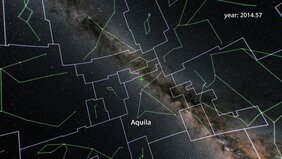The Gaia space observatory has succeeded for the third time in detecting a black hole within the Milky Way. This was made possible by five years of ultra-precise measurements of the slightly fluctuating position of a star in the constellation of the Eagle. This oscillation is caused by an invisible object with 33 times the mass of the Sun, which the star orbits every 12 years. It is the first discovered specimen of a particularly massive category, the origin of which is still largely unknown.
The Astronomisches Rechen-Institut (ARI) at the Centre for Astronomy of Heidelberg University (ZAH) is also playing a leading role in the evaluation of the underlying measurements. "I'm really excited about this discovery. Like countless spectacular results before it, it is once again a great reward for our twenty years of hard work in Gaia data analysis," says Michael Biermann. Biermann heads the largest department of the Gaia data processing consortium at ZAH, which is responsible for the entire complex process of converting the satellite's raw data into the mission's main astrometric product.
According to today's understanding of the evolution of stars with more than a few dozen solar masses, they end up forming black holes. The few such specimens known so far have attracted attention due to their interaction with a neighboring star, from which they suck gas, which is heated to millions of degrees and thus shines extremely brightly. But the black holes found in this way have masses between five and 20 solar masses, according to theoretical expectations. The scientists involved in the discovery are therefore all the more fascinated by the fact that there can obviously be even heavier specimens. They are certain that the black hole, called "Gaia BH3", was formed billions of years ago from a single supernova explosion and was not formed by the merger of a few massive black holes during their chance encounters.
"The scientific consequences of the discovery will only become apparent in the course of the coming years. Many telescopes and measuring instruments will now focus on this object in order to study the properties and behaviour of such a massive black hole at close range for the first time," comments Ulrich Bastian. Bastian was directly involved in the publication on Gaia BH3.
Gaia BH3 proved that it is possible to detect black holes that do not shine brightly. At least that's true for those who pair with a star. There are good reasons to believe that even the majority of black holes are invisible. However, since Gaia has been measuring the motions of more than two billion stars in our Milky Way extremely precisely for ten years - and is expected to continue to do so until the end of 2024 - it can be expected that it will not be limited to the three black holes discovered by Gaia in this way.
His colleague Stefan Jordan is responsible for popular scientific visualizations of the scientific findings from the Gaia mission. "The enormous scientific significance of this discovery has prompted me to create a detailed explanatory video that can be viewed by anyone on YouTube and on ESA's websites," adds Jordan.
Finally, a specimen of the mysterious heavy variant of black holes is now available for close examination on our cosmic doorstep. With a distance of only 2000 light years, it is millions of times closer than any of its kind known to date. For us on earth, however, there is no danger. But researchers who study black holes are still likely to be in a state of great excitement.
PARTICIPATION OF THE ASTRONOMISCHES RECHEN-INSTIUTUT (ARI) IN THE GAIA MISSION
Funded by the state of Baden-Württemberg (via Uni HD) and the German Space Agency DLR, nine scientists are working at ZAH (ARI) for ESA's Gaia project as part of the Gaia scientific consortium DPAC. Some of the central functions of the consortium are located here: Gonzalo Gracia is the scientific coordinator of the 450-member consortium. Michael Biermann heads the largest department of the consortium, which consists of about 90 scientists and is responsible for the entire processing chain from the satellite's raw data to the creation of the mission's main astrometric product. Wolfgang Löffler is the head of the so-called First Look, a complex daily evaluation of raw data to investigate the condition of the instruments on board and the scientific data quality. Stefan Jordan is responsible for the consortium's public relations.
SCIENCE PUBLICATION
Discovery of a dormant 33 solar-mass black hole in pre-release Gaia astrometry, Gaia Collaboration, P. Panuzzo et al., Astronomy & Astrophysics, 2024
ACCOMPANYING DIDACTIC MATERIALS & SOFTWARE
Animation of the BH3 system by Stefan Jordan: https://youtu.be/1gIrm-LTnTo (English long) / https://youtu.be/b3keZFcVnDM (English short)
Gaia Sky Software: https://zah.uni-heidelberg.de/gaia/outreach/gaiasky
Gaia @ZAH/ARI: https://zah.uni-heidelberg.de/gaia
OTHER PRESS RELEASES
ESO Press release: https://www.eso.org/public/news/eso2408/
ESA Press release: https://www.esa.int/Science_Exploration/Space_Science/Gaia/Sleeping_giant_surprises_Gaia_scientists
SCIENTIFIC CONTACT
Dr. Ulrich Bastian
Centre for Astronomy of Heidelberg University (ZAH)
Astronomisches Rechen-Institut (ARI)
bastian@ari.uni-heidelberg.de
CONTACT FOR GAIA SCIENTIFIC ANIMATION AND SOFTWARE
Prof. Dr. Stefan Jordan
Astronomisches Rechen-Institut (ARI)
jordan@ari.uni-heidelberg.de
CONTACT FOR THE MEDIA
Dr. Guido Thimm
Centre for Astronomy of Heidelberg University (ZAH)
thimm@uni-heidelberg.de


